Top Tech Stack for Dating App Development
Manish Kumawat
Last Updated on: 06 November 2025
Do you know? The dating app tech stack is one of the major factors that have a direct impact on all aspects of your dating app development projects. Yes, including cost, time, and complexity of your dating app development projects is directly connected to the tech stack of your dating app. Not only that, but even the success of your dating app is in the choice of your dating app tech stack.
The major reason behind the success of dating platforms like Tinder, Bumble, and Hinge is also the set of technology they use to make their app. Yes, it's just like the foundation or framework of a building. This set of technologies will determine the growth, expansion, and scope of your dating app.
If you are an entrepreneur who wants to build a dating app or an existing dating app owner who wants to redesign it, then this guide is for you. Here we’ll explore the ideal tech stack for dating app development, what top apps like Tinder and Hinge use, and how tech choices influence functionality, user experience, and even algorithmic behavior.
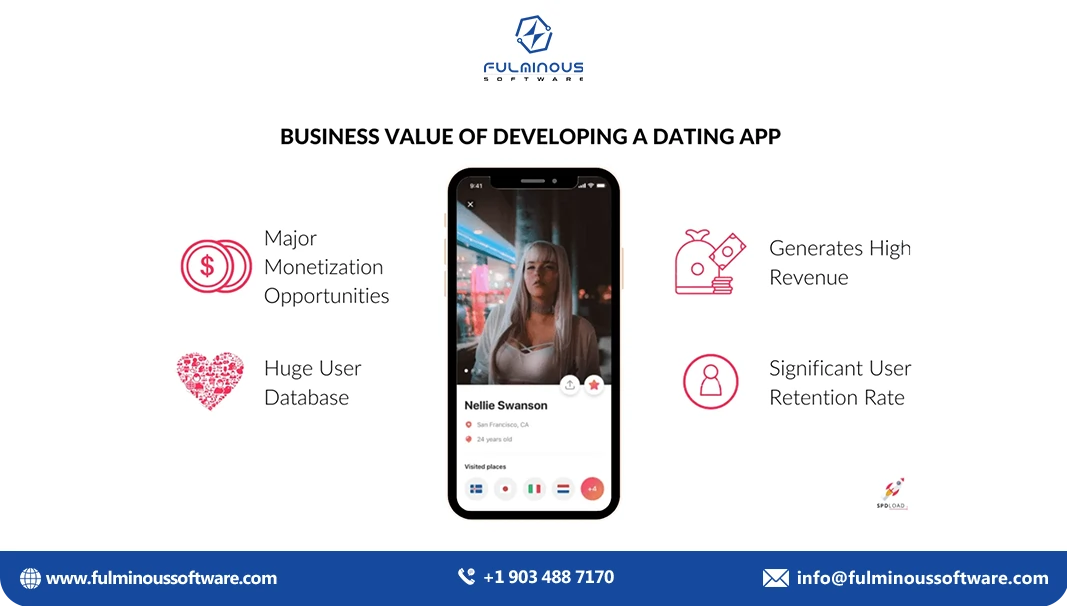
Table of Contents
- 1. What is a Tech Stack?
- 2. Why Choosing the Right Tech Stack Matters
- 3. Key Components of a Dating App Tech Stack
- - Frontend Development
- - Backend Development
- - Database
- - Cloud Hosting & DevOps
- - APIs and Third-party Integrations
- - AI and Machine Learning
- 4. How to Choose the Right Tech Stack for Dating App Development?
- 5. What Tech Stack is Tinder?
- 6. What Tech Stack Does Hinge Use?
- 7. Bumble Tech Stack
- 8. AI: Must-Add to Your Tech Stack
- 9. Inspiration From The Success of Leaders
- 10. Tailored Tech Stack Suggestions
- 11. Dating App Technology Examples
- 12. Addressing Algorithm Attractiveness and Bias
- 13. Everything You Need for Dating App Tech Stacks – Fulminous Software is Here
- 14. Conclusion
- 15. FAQs
What is a Tech Stack?
No need to be confused with this tech term. A tech stack includes:
- programming languages
- Frameworks
- Libraries
- Tools
- Software
In a dating app development tech stack includes:
- Frontend (client-side): UI and UX
- Backend (server-side): Business logic, user authentication, database handling, etc.
- Database: Stores user data, messages, preferences, etc.
- APIs & SDKs: Like maps, chat, payments, and social media login
- AI & ML: For personalization, matchmaking, and content filtering
Why Choosing the Right Tech Stack Matters
Choosing the right tech stack plays a big role in how your dating app performs. If you use outdated technologies, you can guess the result. For a better user experience, you need advanced technologies. Also, the features you want to add, which means the complexity of your dating app, are also based on these technologies.
It also affects the overall cost of your dating app development. Yes, when you choose the latest tech stack, you have to pay more. But one thing is guaranteed: it will bring you the best ROI. Security and privacy are crucial in dating apps, and so your tech stack must be efficient enough to protect user data. A reliable stack keeps things secure.
The availability of a development team for your dating app also depends on the tech stack you choose. If you choose an unpopular or outdated tech stack, you have to search a lot for a development team or experts. Lastly, your tech stack impacts how easy it is to maintain and grow the app. If you choose wisely, adding new features or scaling the app later becomes smooth and stress-free.
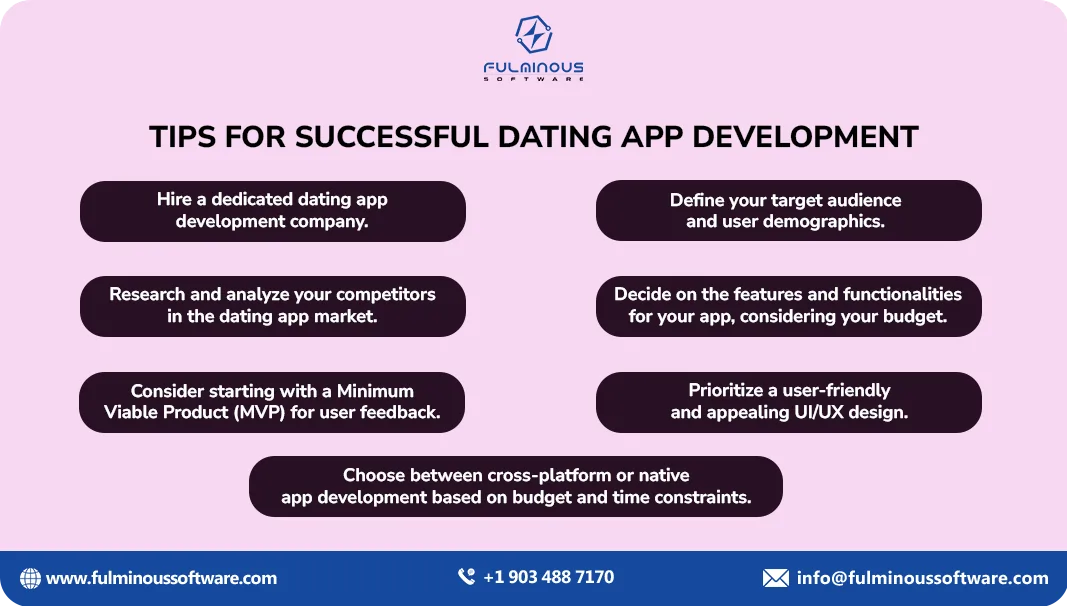
Key Components of a Dating App Tech Stack
1. Frontend Development
The frontend defines how users interact with the app.
Recommended Technologies:
- For cross-platform dating apps (iOS & Android): React Native or Flutter
- Swift (iOS), Kotlin (Android) for native apps
- Redux or Bloc for state management
2. Backend Development
Handles user authentication, matching logic, real-time chat, and more.
Recommended Technologies:
- Node.js or Django (Python) for flexibility and scalability
- Ruby on Rails for rapid development
- Express.js for minimalist Node.js applications
- Firebase for real-time database and backend as a service
3. Database
Dating app database design should ensure:
- Speed
- Data integrity
- Real-time access
Recommended Technologies:
- MongoDB (NoSQL for flexibility)
- PostgreSQL (Relational, supports complex queries)
- Redis (for caching and fast retrieval)
- Firebase Realtime DB for live messaging features
4. Cloud Hosting & DevOps
Ensures your app is fast, secure, and highly available.
Recommended Platforms:
- AWS or Google Cloud Platform
- Docker and Kubernetes for containerization and scalability
- CI/CD tools like Jenkins or GitHub Actions
5. APIs and Third-party Integrations
- Twilio or Socket.io for real-time messaging
- Google Maps API for geolocation
- Stripe or Razorpay for payments
- Facebook/Google Login SDKs for social sign-ins
6. AI and Machine Learning
Modern dating apps rely heavily on dating app algorithms to determine compatibility.
Use Cases:
- Match suggestions based on behavior
- Image recognition for profile filtering
- NLP for chat moderation
Tools & Frameworks:
- TensorFlow, PyTorch
- Scikit-learn
- Amazon SageMaker
How to Choose the Right Tech Stack for Dating App Development?
Now comes the major question: how to choose the ideal tech stack for my dating dapp development? This single decision can have an amazing impact on your business. So, make use of the following 9 tips:
- Define Your App’s Core Features First
- Decide Between Native or Cross-Platform
- Pick a Reliable Backend Technology
- Choose a Scalable & Secure Database
- Think About Real-Time Communication
- Use APIs and Third-Party Tools Wisely
- Don’t Ignore Security & Privacy
- Plan for Future Maintenance & Growth
- Balance Cost and Performance
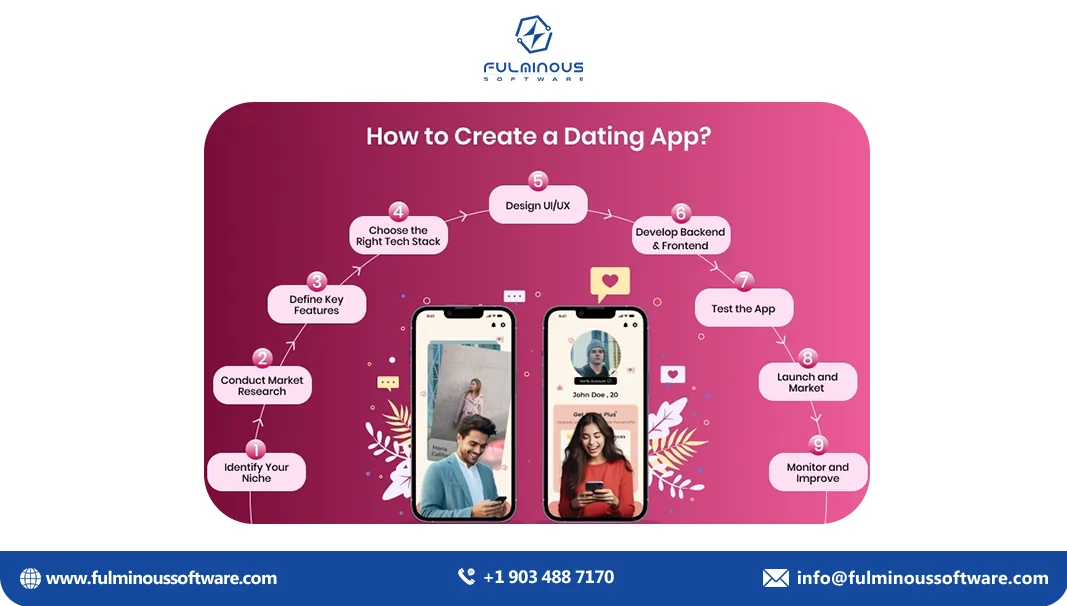
What tech stack is Tinder?
No doubt, Tinder’s popularity and leading position are visible in its 400+ million downloads as per the latest data. ( source ) Do you know the reason behind its 75+ million users? Their tech stack is a major reason behind it. They use:
Frontend: React Native
Backend: Node.js and Express.js
Database: MongoDB, Redis
Hosting: AWS
AI/ML: Machine learning models for match optimization
Other Tools: Kafka for event handling, Elasticsearch for search
Special Features:
- Smart Matching algorithm based on user behavior and location
- Real-time chat using WebSockets for instant messaging
What Tech Stack Does Hinge Use?
Hinge is another leading dating app with 23+ million users. ( source ) With $550 million in revenue in the last year, this dating app also shows the relevance of the tech stack. Hinge tech stack is:
Frontend: React Native
Backend: Python (Django)
Database: PostgreSQL
Hosting: AWS
Special Features:
- Uses Machine Learning for personalized match recommendations
- Advanced filtering options for preferences
Bumble Tech Stack
With 50 million active users and a 2% revenue increase in the last year, Bumble remains in its leading position in the industry. (source) They also achieved success with a strong tech stack.
Frontend: Swift (iOS), Kotlin (Android)
Backend: Node.js
Database: Amazon DynamoDB, Redis
Hosting: AWS
Special Features:
- Women-first messaging feature for better user control
- Real-time chat and swipe-based matching
- Integration of geolocation and push notifications for engagement
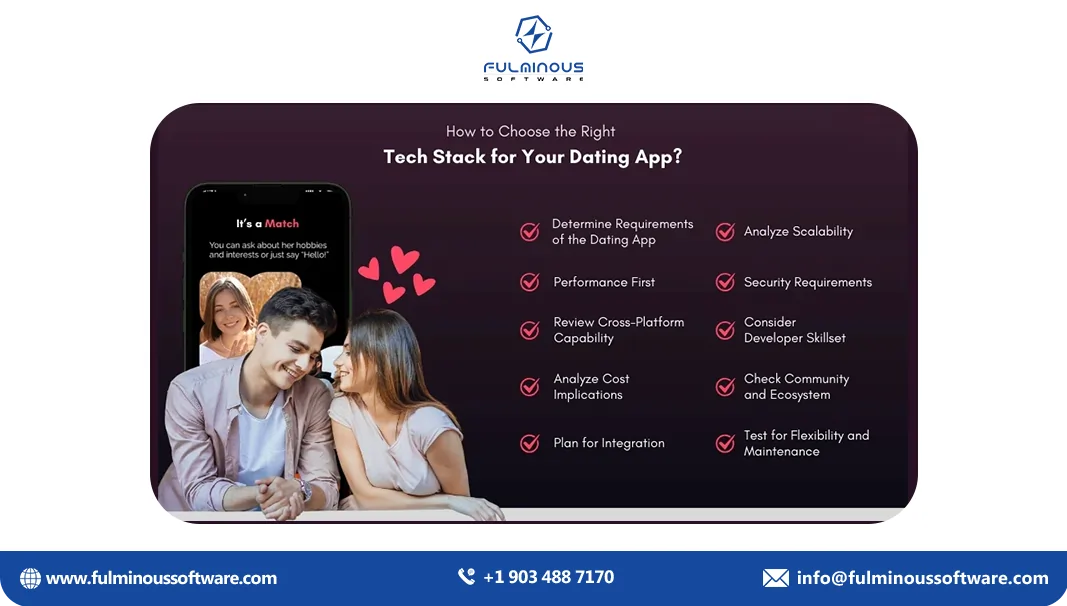
AI: Must-Add to Your Tech Stack
AI is now used in most dating apps to offer smarter matches. It studies user behavior and preferences to suggest better connections and improve the overall experience. From chatbots to safety features, AI adds many smart tools to dating apps. It helps users find real people faster and enjoy smoother, more personalized app journeys.
Inspiration From The Success of Leaders
The success story of these dating app leaders is giving strong evidence that their success is driven by their tech stack. This is a great inspiration and encouragement for those who looking to develop a dating app or redesign their existing dating app.
Tailored Tech Stack Suggestions
|
MVP Tech Stack (Minimum Viable Product) Frontend: Flutter Backend: Firebase + Node.js Database: Firebase Realtime DB + Firestore Hosting: Google Cloud Functions Pros: Fast launch, minimal costs, scalable |
Enterprise-Grade Dating App Stack Frontend: React Native with Redux Backend: Node.js + Express.js or Django Database: PostgreSQL + Redis AI/ML: TensorFlow + AWS SageMaker Hosting: AWS EC2 + Docker + Kubernetes Pros: Scalable, custom, secure, and ready for millions of users |
Dating App Technology Examples
Here are some dating app technology use cases from real-world apps
| Feature | Technology |
|---|---|
| Swipe Functionality | React Native Gestures |
| Real-time Chat | WebSockets, Twilio, Firebase |
| Matchmaking | Python ML models |
| Push Notifications | Firebase Cloud Messaging |
| Geolocation | Google Maps API |
| Social Login | Facebook/Google OAuth |
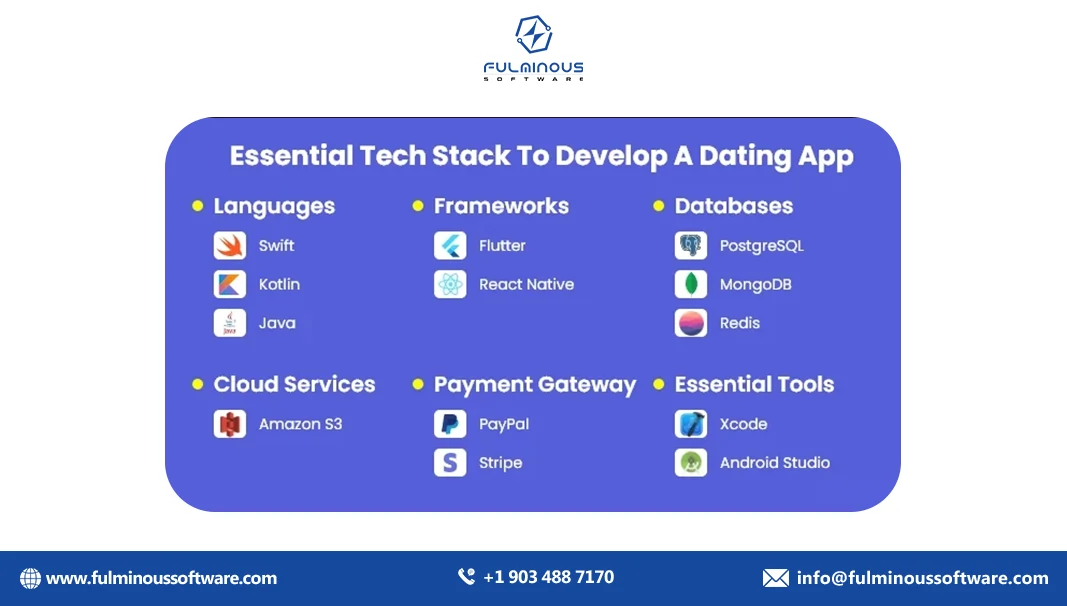
Addressing Algorithm Attractiveness and Bias
Dating App Algorithm Attractiveness
This refers to how algorithms rank and match people based on activity, appearance, and interaction patterns. Apps like Tinder may use:
- Elo score (a rating system)
- Engagement rates
- Profile completeness
Dating App Algorithm Bias
Bias can enter through dataset imbalance or poor training logic. To reduce bias:
- Use diverse training data
- Regularly audit ML models
- Allow user-driven discovery options
Everything You Need for Dating App Tech Stacks – Fulminous Software is Here
You might have worried about too many tech terms mentioned above. But don't worry, Fulminous Software offers complete support, from picking the right tech stack to building feature-packed dating apps.
Dating App Tech Stack Consulting
- We guide you in choosing the right tech stack based on your goals, users, and budget.
- Our team stays updated with the latest tools, frameworks, and industry best practices.
- We offer clear, expert advice so your app is fast, secure, and easy to scale.
Dating App Development with Trending Tech Stack
- We use modern tools like AI, machine learning, and cloud hosting to build smart, powerful apps.
- Whether it’s Android, iOS, or cross-platform, we build feature-rich dating apps.
- Real-time chat, smart matching, and location-based features – we do it all using the best tech.
Conclusion
The dating app tech stack is the driving force of a dating app’s success. Choosing the right tech stack according to your goals and budget will bring the expected results fr you. The assistance of a leading dating app development company like Fulminous Software is essential to achieve this easily. So, collaborate and build the best dating app. Share this article.
FAQs
Q1. What is the best dating app tech stack for startups?
The best dating app tech stack includes React Native, Node.js, MongoDB, and AWS, balancing performance, cost, and scalability.
Q2. What tech stack does Hinge use?
Hinge tech stack includes React Native for frontend, Python (Django) for backend, PostgreSQL for database, and AWS. It uses AI for personalized matching and filtering features.
Q3. Bumble tech stack – What powers it?
The Bumble tech stack includes Swift and Kotlin for mobile apps, Node.js backend, DynamoDB and Redis for database, AWS hosting, and geolocation, plus chat functionalities.
Q4. Why is the Dating app database design important?
Overall functioning of a dating app depends on the Dating app database design. Tools like MongoDB, PostgreSQL, and Firebase support profile storage, messaging, preferences, and matching data efficiently.
Q5. How does a Dating app algorithm attractiveness and bias work?
Dating app algorithm attractiveness uses user behavior data and AI to score profiles. However, bias can occur if training data lacks diversity, impacting match fairness.
Q6. What tech stack is Tinder?
Tinder uses a Dating app technology examples: React Native frontend, Node.js backend, MongoDB and Redis for database, AWS hosting, plus machine learning for match suggestions and real-time chat.
HIRE A TOP SOFTWARE DEVELOPMENT COMPANY

 Verified
Expert in Software & Web App Engineering
Verified
Expert in Software & Web App Engineering
I am Manish Kumawat, co-founder of Fulminous Software, a top leading customized software design and development company with a global presence in the USA, Australia, UK, and Europe. Over the last 10+ years, I am designing and developing web applications, e-commerce online stores, and software solutions custom tailored according to business industries needs. Being an experienced entrepreneur and research professional my main vision is to enlighten business owners, and worldwide audiences to provide in-depth IT sector knowledge with latest IT trends to grow businesses online.
Partner with Top-Notch Web Application Development Company!
Discuss your Custom Application Requirements on info@fulminoussoftware.com or call us on +1-903 488 7170.
15 Days Risk-Free Trial

